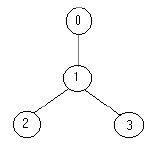Strategic Game
Time Limit: 20000/10000 MS (Java/Others) Memory Limit: 65536/32768 K (Java/Others)
Total Submission(s): 7328 Accepted Submission(s): 3481
Problem Description
Bob
enjoys playing computer games, especially strategic games, but
sometimes he cannot find the solution fast enough and then he is very
sad. Now he has the following problem. He must defend a medieval city,
the roads of which form a tree. He has to put the minimum number of
soldiers on the nodes so that they can observe all the edges. Can you
help him?
Your program should find the minimum number of soldiers that Bob has to put for a given tree.
The input file contains several data sets in text format. Each data set represents a tree with the following description:
the number of nodes
the description of each node in the following format
node_identifier:(number_of_roads) node_identifier1 node_identifier2 ... node_identifier
or
node_identifier:(0)
The node identifiers are integer numbers between 0 and n-1, for n nodes (0 < n <= 1500). Every edge appears only once in the input data.
For example for the tree:

the solution is one soldier ( at the node 1).
The output should be printed on the standard output. For each given input data set, print one integer number in a single line that gives the result (the minimum number of soldiers). An example is given in the following table:
Your program should find the minimum number of soldiers that Bob has to put for a given tree.
The input file contains several data sets in text format. Each data set represents a tree with the following description:
the number of nodes
the description of each node in the following format
node_identifier:(number_of_roads) node_identifier1 node_identifier2 ... node_identifier
or
node_identifier:(0)
The node identifiers are integer numbers between 0 and n-1, for n nodes (0 < n <= 1500). Every edge appears only once in the input data.
For example for the tree:

the solution is one soldier ( at the node 1).
The output should be printed on the standard output. For each given input data set, print one integer number in a single line that gives the result (the minimum number of soldiers). An example is given in the following table:
Sample Input
4
0:(1) 1
1:(2) 2 3
2:(0)
3:(0)
5
3:(3) 1 4 2
1:(1) 0
2:(0)
0:(0)
4:(0)
Sample Output
1
2
Source
现在学了二分图直接可以用最小点覆盖集解,这题所有点都在同一集合里面,所以建造二分图的时候要连双向边,结果要除二。
#include<iostream> #include<cstdio> #include<cstring> #include <algorithm> #include <math.h> using namespace std; const int N = 1505; struct Edge{ int v,next; }edge[N*N]; int head[N],tot; void addEdge(int u,int v,int &k){ edge[k].v = v,edge[k].next = head[u],head[u] = k++; } void init(){ memset(head,-1,sizeof(head)); tot = 0; } int linker[N]; bool vis[N]; int n; bool dfs(int u){ for(int k=head[u];k!=-1;k=edge[k].next){ int v = edge[k].v; if(!vis[v]){ vis[v] = true; if(linker[v]==-1||dfs(linker[v])){ linker[v] = u; return true; } } } return false; } int main() { while(scanf("%d",&n)!=EOF){ init(); for(int i=1;i<=n;i++){ int u,v,num; scanf("%d:(%d)",&u,&num); for(int j=1;j<=num;j++){ scanf("%d",&v); addEdge(u,v,tot); addEdge(v,u,tot); } } int res = 0; memset(linker,-1,sizeof(linker)); for(int i=0;i<n;i++){ memset(vis,0,sizeof(vis)); if(dfs(i)) res++; } printf("%d ",res/2); } return 0; }